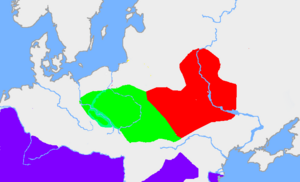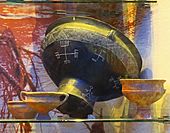Przeworsk culture facts for kids

The Przeworsk culture was an important group of people who lived in what is now Poland. They existed during the Iron Age, from about 300 BC to 500 AD. We call it a "culture" because archaeologists found similar types of tools, pottery, and burial styles in this area.
The culture is named after the town of Przeworsk. This is where the first old objects, called artifacts, from this group were found.
At first, the Przeworsk culture was mainly in central and southern Poland. This area is around the upper parts of the Oder and Vistula rivers. Over time, it spread south into the Carpathians mountains and east towards the Dniester river.
This culture was influenced by other groups. It took ideas from the Celtic La Tène culture from the southwest. It also had connections with the Jastorf culture to its west. To the east, the Przeworsk culture was linked to the Zarubintsy culture.
Contents
How the Culture Developed
Experts believe the Przeworsk culture was a mix of many local groups. It seemed to appear quite suddenly. This happened as people adopted new technologies from the Celtic La Tène culture.
The Przeworsk culture was very different from earlier cultures in the area, like the Pomeranian culture. To the northwest, the Przeworsk people also had strong connections with the Jastorf Culture. This culture is linked to early Germanic tribes.
To the east, the Przeworsk culture was connected to the Zarubintsy culture. This culture was found in what is now northern Ukraine and southern Belarus. Some historians think these groups might be linked to the Early Slavs. Later, other cultures like the Wielbark culture and Chernyakhov culture took over parts of this eastern area.
Daily Life and Customs
People of the Przeworsk culture lived in small villages. These villages usually had only a few dozen people. Each village had several houses, often built partly underground. These houses were about 8 to 22 square meters in size.
They were skilled at digging wells. This meant their villages did not always need to be right next to a river or lake. For example, archaeologists found thirteen wells from the 2nd century at a village in Stanisławice. These wells had walls made of timber.
The people used their land for farming crops. They also used it for raising animals. Sometimes, they would let animals graze on fields after crops were harvested. This helped the soil become fertile again. When iron plows were invented, they would switch between growing crops and grazing animals on their fields.
Several villages together formed a "micro-region." People in these regions worked together on things like farming. They also shared a common cemetery to bury their dead. These micro-regions were often separated from others by empty land.
Many micro-regions might have formed a larger group, like a tribe. These tribes sometimes worked together, especially for wars. They might even have formed early forms of states.
Archaeologists found a place in Chabsk where the Przeworsk people extracted salt from salt springs. This was a kind of industrial complex around the year 0 AD.
Burial Practices
Archaeologists have studied many burial grounds from the Przeworsk culture. Even the largest cemeteries, used for hundreds of years, have only a few hundred graves. This tells us that not many people lived in the area.
The Przeworsk people mostly cremated their dead. This means they burned the bodies. The ashes were sometimes placed in special pots called urns. These urns often had a unique shape with an engraved bulge in the middle. Later, in the 1st century AD, the urns changed to a shape with a sharp horizontal ridge.
One interesting discovery was a warrior's grave in Siemiechów. This warrior might have been part of a military expedition around 70-50 BC. His grave contained Celtic weapons. It also had a helmet from the Alpine region, which was used as an urn. Local pottery was also found there.
Often, the items buried with the dead were bent or broken before being burned. We don't know why they did this. Some burials were "poor," with few items. Others were "rich," with fancy Celtic and Roman imported goods. This shows that society was becoming more organized, with different social classes.
Warrior burials are special because they often include horse gear and spurs. Some of these graves are very rich, even more so than graves of Germanic groups further west, especially after 400 AD. The pottery and metalwork found are often beautiful and show many different styles.
Who Were the Przeworsk People?
The Przeworsk culture was likely made up of different ancient groups of people. In old writings, this culture was linked to a group called the Lugii. Among Germanic peoples, the Przeworsk culture is often connected to the Vandals. However, the Vandals were probably just one part of this larger culture.
The Przeworsk culture has also been linked to the early Slavs. Recent studies looked at the bones of people from the Przeworsk, Wielbark, and Cherniakhovo cultures. These studies suggest that these ancient people were more similar to the early medieval West Slavs than to medieval Germanic-speaking groups.
Why the Culture Declined
The Przeworsk culture started to decline in the late 5th century AD. This time matches with the invasion of the Huns. Other reasons for its decline might include problems that arose when the Roman world started to collapse. The Romans had important trade connections with people outside their empire, and these connections broke down.
After the Przeworsk culture, a new culture appeared in the Vistula river area. This was the early Slavic Prague-Korchak culture, which emerged in the late 5th or early 6th century.
See also
 In Spanish: Cultura de Przeworsk para niños
In Spanish: Cultura de Przeworsk para niños
- Przeworsk culture settlements and burial sites
- Early Slavs
- Vandals
- Amber Road








